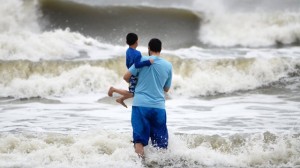Hurricane Sandy menaces US coast
As mammoth storm system Hurricane Sandy conspired to assault the most populous part of the United States, hundreds of thousands of people moved to higher ground and cities announced shutdowns that typically occur after several feet of snow.
The Washington region’s entire public transit system (Metro, Virginia Railway Express and the Maryland Transportation System) ceased operations. Schools, colleges and universities closed Monday, and some have already announced they’ll close Tuesday and Wednesday as well.
Cities north along the Eastern Seaboard took similar action. New York Mayor Michael R. Bloomberg (I) ordered the evacuation of Coney Island and Lower Manhattan, and authorities shut down the city’s schools and its subway system, effectively bringing the nation’s largest city to a near halt. More than 60 miles inland, Philadelphia Mayor Michael Nutter (D) urged people to leave low-lying neighborhoods.
Even the New York Stock Exchange will close floor trading on Monday and move to an electronic-only system.
A superstorm that threatened 50 million people in the most heavily populated corridor in the nation started turning Monday – forecasters said.
Hurricane Sandy was expected to hook inland during the day, colliding with a wintry storm moving in from the west and cold air streaming down from the Arctic.
The National Hurricane Center said early Monday that the Category 1 hurricane has top sustained winds of 75 mph, with higher gusts. It is moving toward the north at 14 mph after moving northeast Sunday night. Hurricane-force winds extend up to 175 miles from the storm’s center. Gale force winds were reported over coastal North Carolina, southeastern Virginia, the Delmarva Peninsula and coastal New Jersey.
Sandy is about 425 miles southeast of New York City and the center of the storm is expected to be near the mid-Atlantic coast on Monday night.
From Washington to Boston, big cities and small towns were buttoned up against the onslaught of Sandy, with forecasters warning that the New York area could get the worst of it — an 11-foot wall of water.
“The time for preparing and talking is about over” – Federal Emergency Management Administrator Craig Fugate said Sunday as Hurricane Sandy made its way up the Atlantic on a collision course with two other weather systems that could turn it into one of the most fearsome storms on record in the U.S. “People need to be acting now.”
About 50 million people from the Mid-Atlantic to Canada were in the path of the storm, which forecasters say could be the largest ever to hit the U.S. mainland. It is expected to topple trees, damage buildings and cause widespread power outages over the next few days.
Sandy, which killed 66 people in the Caribbean and has brought lashing rains to coastal areas and snow at higher elevations, will cause extensive flooding when it moves inland, forecasters said.
The websites of forecasting services indicated early Monday the storm will strike the New Jersey shore near Atlantic City Monday night.
While Sandy does not pack the punch of Hurricane Katrina, which devastated New Orleans in 2005, its winds stretch some 520 miles from its eye – meteorologists said.
New York and other cities and towns closed their transit systems and schools and ordered mass evacuations from low-lying areas ahead of a storm surge that could reach as high as 11 feet.
All U.S. stock markets will be closed on Monday and possibly Tuesday, the operator of the New York Stock Exchange said late on Sunday, reversing an earlier plan that would have kept electronic trading going on Monday.
Sandy forced President Barack Obama and Republican challenger Mitt Romney to cancel some campaign stops and fueled fears that it could disrupt early voting (encouraged by the candidates this year more than ever) before the November 6 election.
The United Nations, Broadway theaters, New Jersey casinos, schools up and down the Eastern Seaboard, and myriad corporate events are also being shut down.
